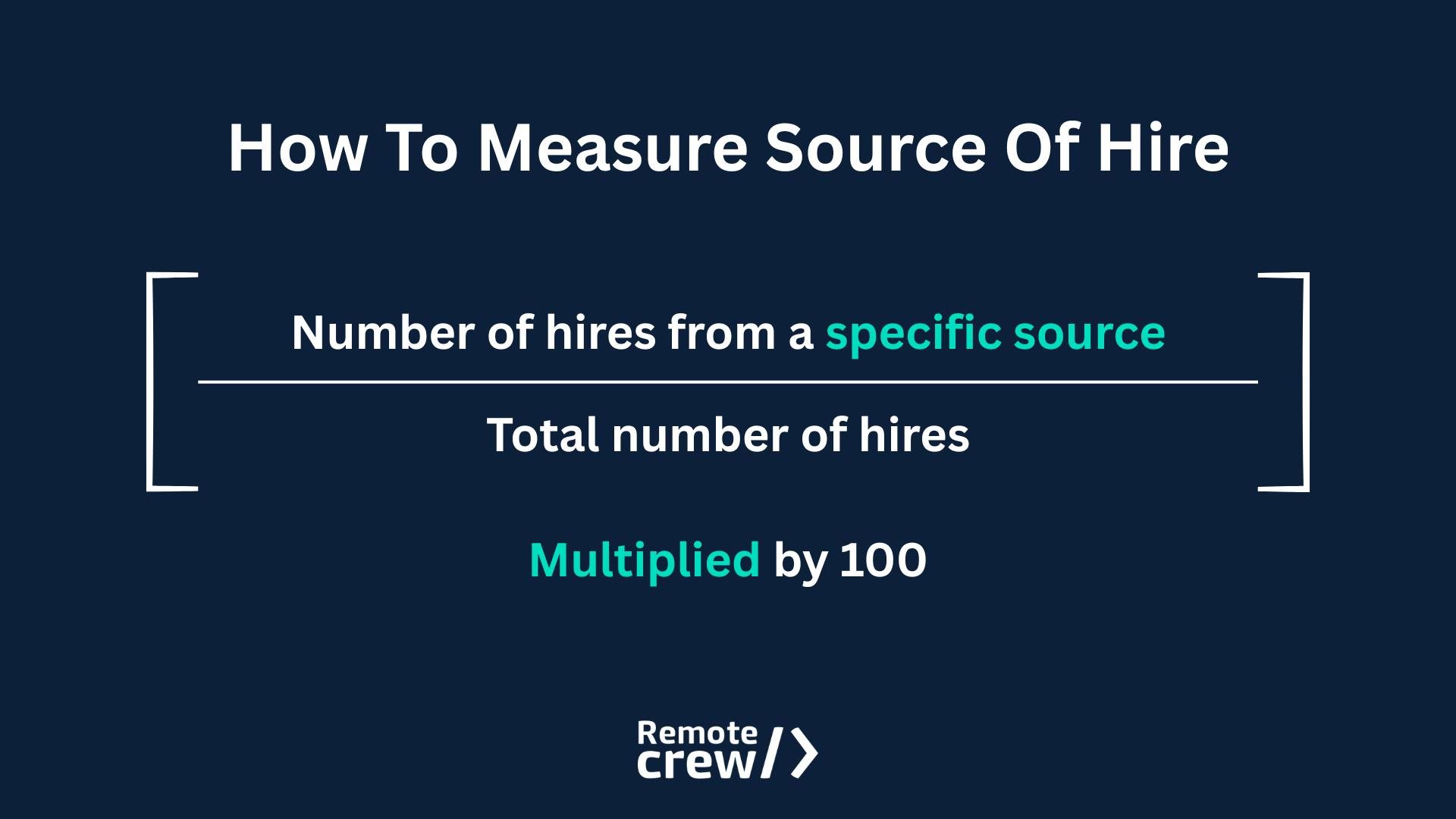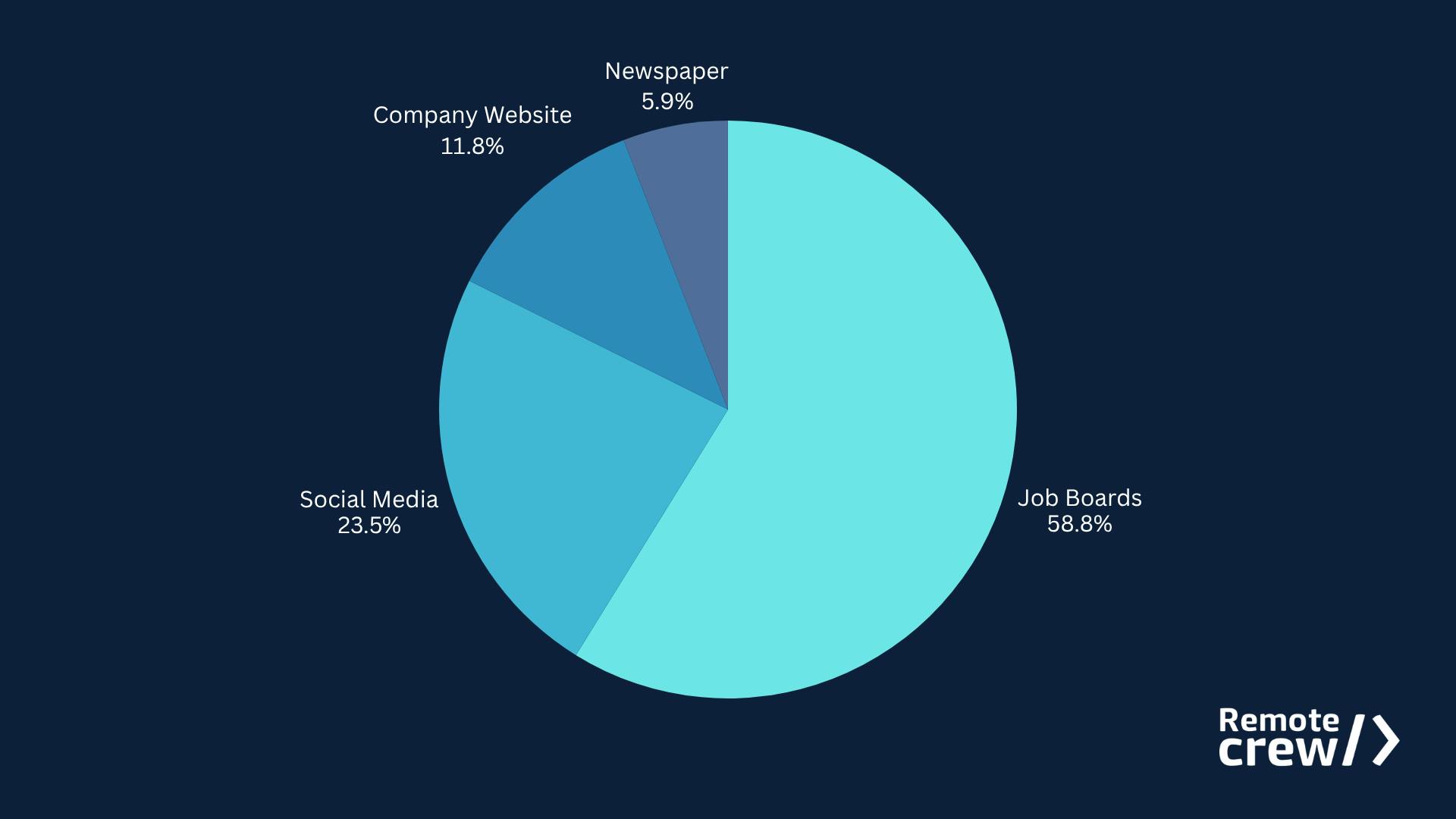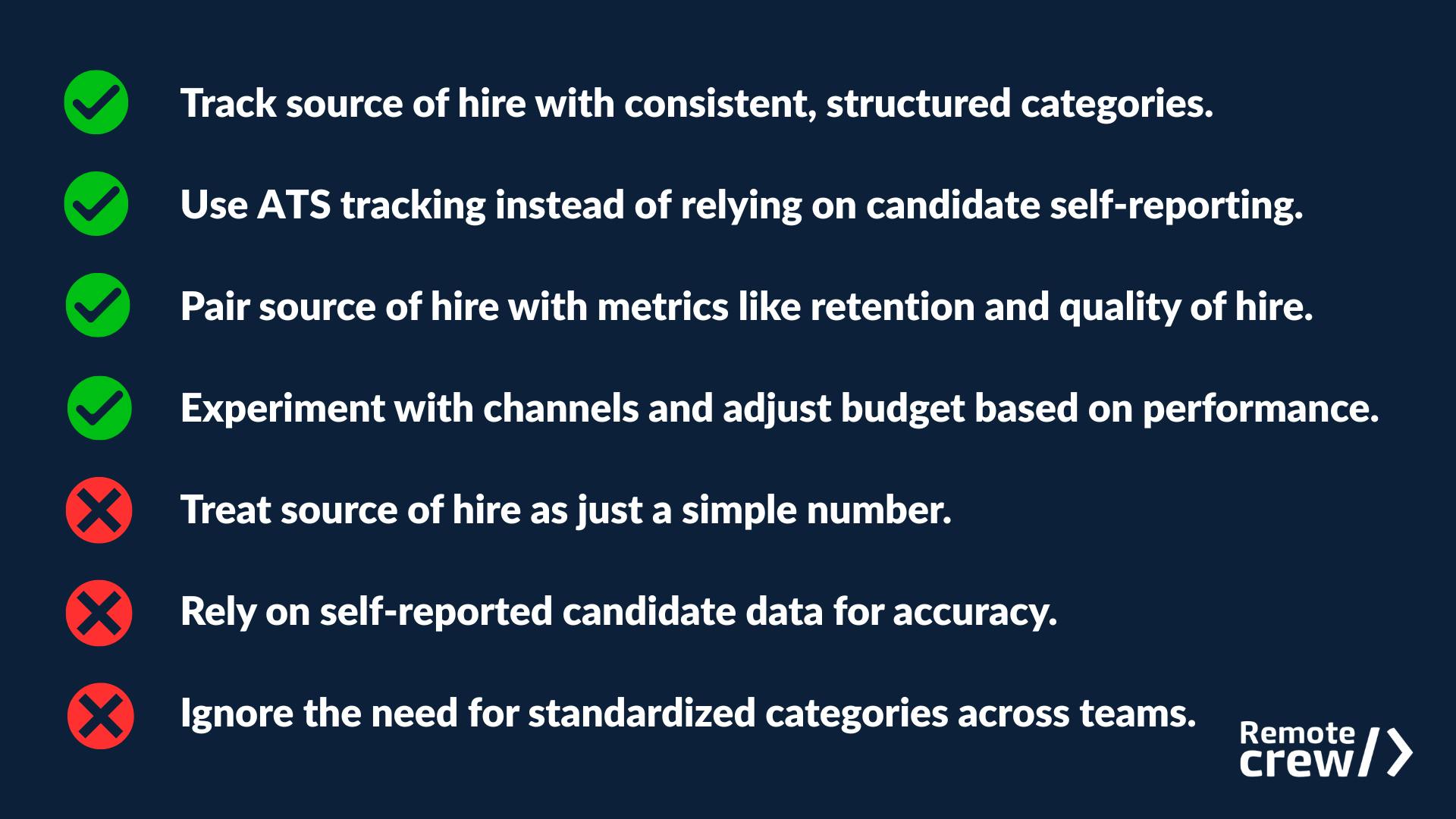Knowing how to measure source of hire is key to finding the origin point of a candidate’s journey into your recruitment funnel.
Straight off the bat, here are four distinct sources of hire:
- Referral
- Job board
- Social media post
- Career website
Prospective candidates can come from a variety of places, and each channel reveals something about where your energy and resources are producing results.
When we see a wave of professionals applying from job boards, we double down on this channel.
What does “doubling down” look like? Well, in the case of job boards, we may pay for premium listings with increased exposure or post the job vacancy across more boards.
If we notice that, for example, social media posts aren’t generating any applications, we’ll pause any advertising spend that we’ve thrown behind those social media posts.
We like to think of it as a constant game of experimentation.
Our team at Remote Crew never takes the same approach for all clients.
Sure, we go into hiring campaigns with knowledge of what’s worked for others filling similar positions, but we’re always ready to test new strategies.
That’s part of what makes my role interesting.
I’ve found that recruiters sometimes misinterpret the “source of hire” metric as a simple number attached to platforms.
Don’t think of it like that. I’m more interested in using the metric to map every pathway talent follows.
How Can You Measure Source Of Hire?
Data quality determines the reliability of source of hire reporting.
Without consistent collection practices, you’ll struggle to get an accurate picture of how your candidate sourcing breaks down percentage-wise.

You need a uniform structure across every requisition for clarity.
We often see hiring teams rely on candidate self-reporting.
This is not recommended.
Self-reporting creates inaccuracies when individuals misremember or choose the simplest answer.
Tracking through applicant tracking systems introduces some discipline into the process.
Our team at Remote Crew can set up source of hire tracking in your ATS.
Clean fields and structured categories prevent confusion when reports are exported.
Why Does Attribution Influence Hiring Velocity?
Attribution defines how quickly a recruiter identifies where the strongest candidates emerge.
Some channels produce large pools yet slow down the evaluation phase, while others will generate highly engaged applicants that move swiftly through assessments.

What we’ve seen is that referrals accelerate acceptance rates at a pace job boards cannot replicate.
The immediacy of trust embedded in a referral drives faster movement through interviews.
That shift in velocity compounds when organizations are scaling.
What Happens When You Compare Paid And Organic Sources?
This is where it gets interesting.
Paid campaigns often create a surge in volume but may demand heavier screening efforts.
Organic outreach or networking generates fewer applicants, but from what we’ve seen, conversion rates frequently outperform.
My team has observed marketing-style testing applied in recruitment.
Allocating budget toward specific campaigns, then measuring which produce lasting hires, allows companies to move resources with purpose.
I’ve found that this creates a sharper sense of cost efficiency in the hiring pipeline.
How Can Source Of Hire Improve Workforce Planning?
Long-term headcount strategies depend on anticipating which channels remain reliable over time.
If career site applicants steadily deliver, recruiters can build workforce models around that consistency.
When employee referrals spike unpredictably, those hires are valuable yet less dependable for forecasting.
Source of hire data makes it possible to align recruitment strategies with leadership planning.
Talent acquisition teams move from reactive outreach toward proactive pipeline design.
This creates stability when leaders are planning expansions or entering new regions.
What Metrics Pair Best With Source Of Hire?
From my experience, source of hire on its own gives only directional insight.
I want you to think about pairing it with other metrics to create a fuller picture.
Source of Hire | % of Total Hires | Quality of Hire (Average Performance Rating) | Retention (1 year) | Time to Fill | Cost per Hire | Offer Acceptance Rate |
Referrals | 35% | 4.5 / 5 | 92% | 25 days | €1,200 | 85% |
Job Board A | 25% | 3.8 / 5 | 70% | 40 days | €2,800 | 62% |
20% | 4.1 / 5 | 80% | 32 days | €2,200 | 73% | |
Agency | 15% | 4.0 / 5 | 75% | 18 days | €6,500 | 68% |
Careers Page | 5% | 3.9 / 5 | 65% | 55 days | €1,000 | 50% |
We've noticed that when retention data is layered onto source of hire reports, clear stories appear.
One channel may dominate initial inflows but result in short tenure, whereas another may deliver smaller numbers but yield employees who grow into leadership roles.
We want this level of detail as it allows us to adjust our focus with data to back it up.
Why Do Global Teams Depend On Consistency In Tracking?
When we are hiring remote developers for teams spread across multiple countries, data integrity becomes fragile.
We find that regions may interpret categories differently unless strict guidelines exist.
The result can be misleading reports that disguise strengths and weaknesses across markets.
What we’ve seen is that multinational teams often fail to enforce the same taxonomy across every location.
In practice, this looks like:
- One region logs “LinkedIn” while another logs “Social Media” for the same source.
- Job boards are tracked under local brand names, making global comparisons impossible.
- Employee referrals are sometimes tagged as “Direct” instead of “Referral.”
- Agency hires may be bundled into “External” in one country and “Recruiter” in another.
- Internal transfers get mixed into external hires because categories aren’t enforced.
Without standardized categories, leadership receives fragmented pictures of global talent flows.
Consistent frameworks safeguard against that problem, enabling accurate worldwide analysis of source of hire.
How Does Employer Branding Connect With Source Of Hire?
A strong employer brand reshapes source of hire distribution.
As recognition grows, career site applications increase while reliance on paid ads decreases.
Source of Hire | Before Branding | After Branding |
Career Site | 15% | 30% |
Referrals | 20% | 25% |
10% | 20% | |
Job Boards | 40% | 15% |
Agencies | 15% | 10% |
Generally speaking, candidates entering through brand-driven channels arrive with higher awareness of company culture.
Their alignment creates smoother integration after hiring.
This means that organizations see not only stronger recruitment outcomes but also healthier long-term engagement.
My team is always focused on helping organizations play to their strengths so we can attract as many high-quality candidates as possible.
What Is The Real Impact On Recruitment Success?
For me, source of hire creates an evidence trail connecting initial outreach to real results.
I want to know what works.

We believe the unpredictable element of human behavior makes continuous measurement important.
Trends shift, platforms rise and fall, and talent preferences change over time.
Without consistent tracking of source of hire, your recruitment efforts will become reactive and fragile.
We avoid this by internalizing the metric as a feedback loop that our team can learn from.
Do you need remote technology recruitment services for your startup? We help startups hire the best remote talent. You can start hiring with Remote Crew today.
Tech hiring insights in your inbox
From engineers to engineers: helping founders and engineering leaders hire technical talent.
We will only ever send you relevant content. Unsubscribe anytime.







